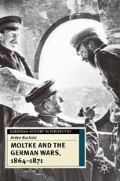Abstract
By the summer of 1870 deep future-oriented war-planning processes had been developing in the kingdom of Prussia for over 70 years. Three, almost four, generations of officers had wrestled with this novel technology. But little showed outside; 1864 did not reveal much. Denmark was a minor kingdom, a small war in the snow. And 1866, though a major surprise upending power relationships in central Europe, did not catch everyone’s attention.
Preview
Unable to display preview. Download preview PDF.
Notes
Lilian Handlin, George Bancroft, the Intellectual as Democrat (New York, 1984), p. 295
Russell B. Nye, George Bancroft, Brahmin Rebel (New York, 1944), pp. 267–78.
M. A. DeWolfe Howe, The Life and Letters of George Bancroft (2 vols, 1971) (originally published in 1908), Vol. II, pp. 219–20.
Harry Bell, St. Privat, German Sources (1914), Appendix A, pp. 473–7.
Dennis Showalter, ‘Prussian Technology and War: Artillery from 1815 to 1914’ in Ronald Haycock and Keith Neilson, Men, Machines and War (Waterloo, 1987), p. 125.
Dennis Showalter, Railroads and Rifles: Soldiers, Technology and the Unification of Germany (Hamden, 1975), is useful on artillery questions.
There is a description of this terrain and the opening phase of the 1870 War in Patrick O’Sullivan and Jesse W. Miller, Jr, The Geography of Warfare (New York, 1983), pp. 69–73.
Dennis Showalter, ‘Soldiers into Postmasters? The Electric Telegraph as an Instrument of Command in the Prussian Army’, Military Affairs, Vol. 46, No. 2 (April 1973), pp. 48–52.
Thomas J. Adriance, The Last Gaiter Button: a Study of the Mobilization and Concentration of the French Army in the War of 1870 (Westport, Conn., 1982)
Richard Holmes, The Road to Sedan: the French Army, 1866–70 (London, 1984).
Scott Lackey, ‘The Habsburg Army and the Franco-Prussian War: the Failure to Intervene and its Consequences’, War in History, Vol. 2, No. 2 (1995), p. 169.
G. F. R. Henderson, The Battle of Spicheren (London, 1902), describes and analyses this battle in great detail. Especially good for artillery.
D. Ascoli, A Day of Battle: Mars-La-Tour, 16 August 1870 (London, 1987), p. 73.
J. M. Thompson, Louis Napoleon and the Second Empire (New York, 1955), p. 313
Alistair Horne, The Fall of Paris (New York, 1967), p. 57.
Copyright information
© 2001 Arden Bucholz
About this chapter
Cite this chapter
Bucholz, A. (2001). The French War, 1870–71. In: Moltke and the German Wars, 1864–1871. European History in Perspective. Palgrave, London. https://doi.org/10.1007/978-1-137-03799-2_7
Download citation
DOI: https://doi.org/10.1007/978-1-137-03799-2_7
Publisher Name: Palgrave, London
Print ISBN: 978-0-333-68758-1
Online ISBN: 978-1-137-03799-2
eBook Packages: Palgrave History CollectionHistory (R0)

